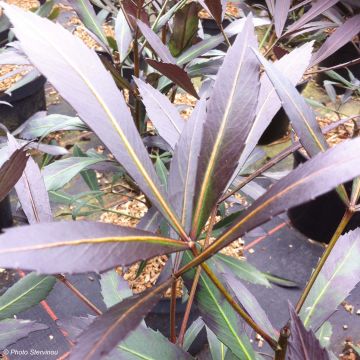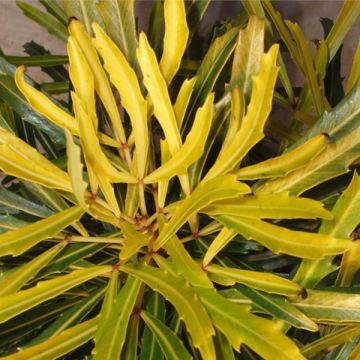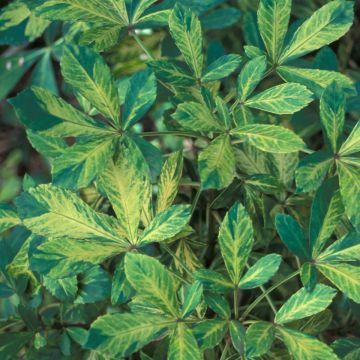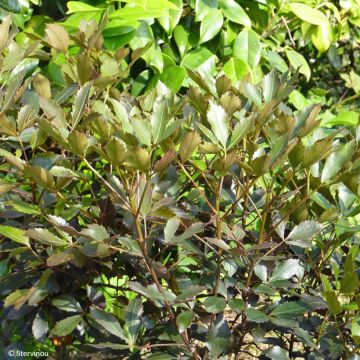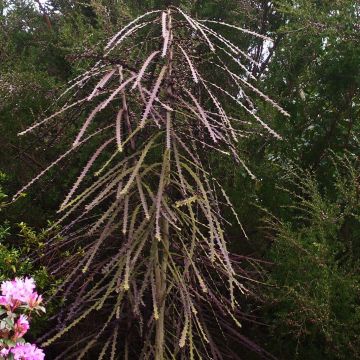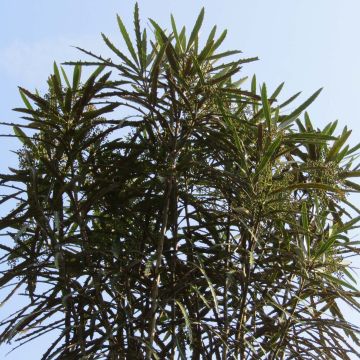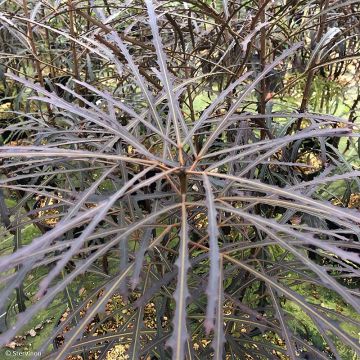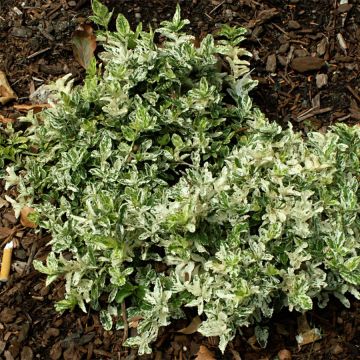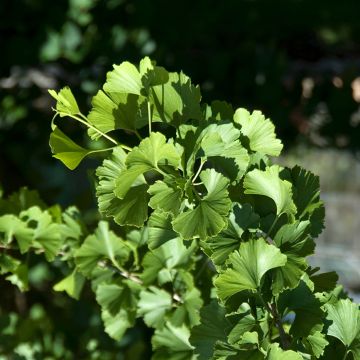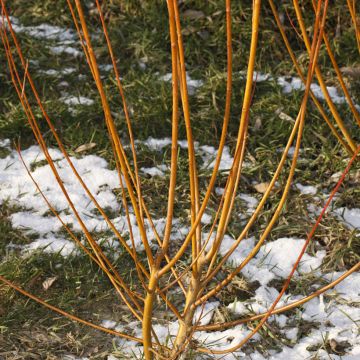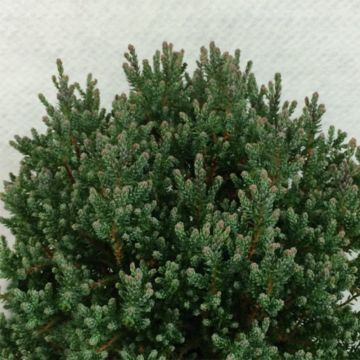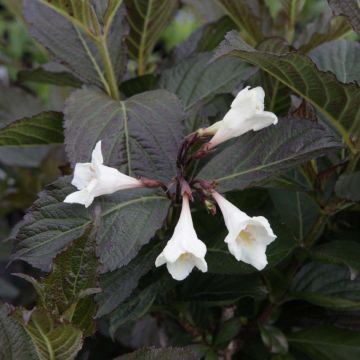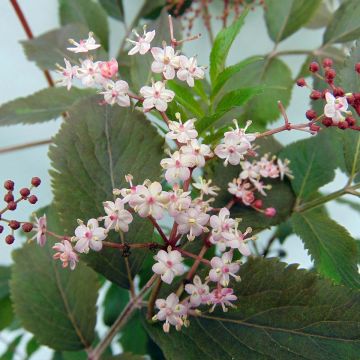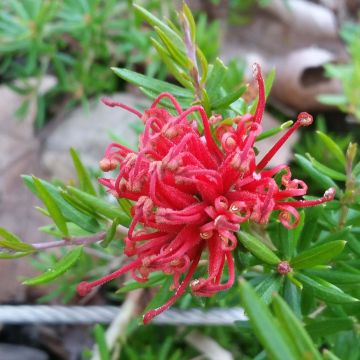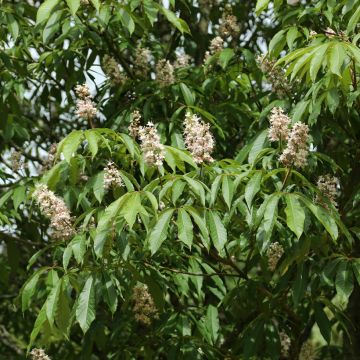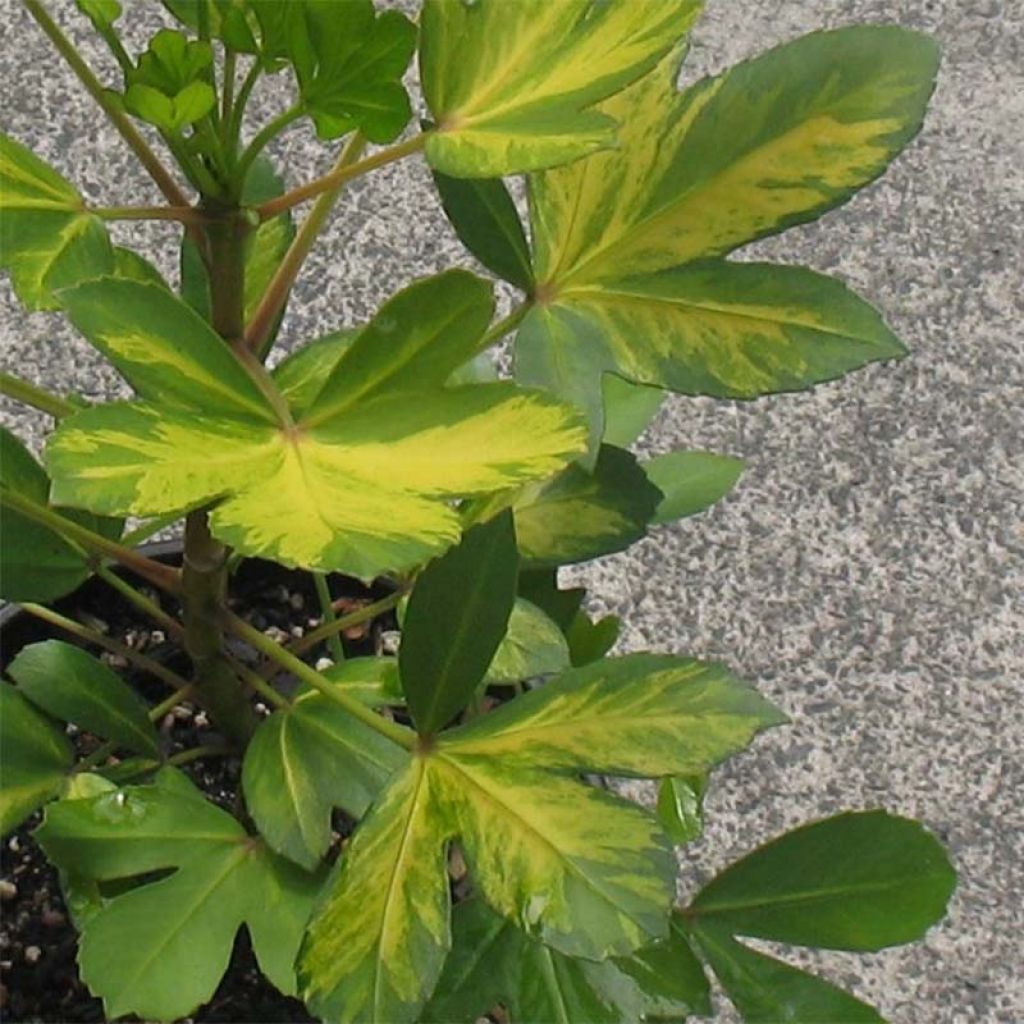

Pseudopanax Gecko Gold
Pseudopanax Gecko Gold
Pseudopanax x lessonii Gecko Gold
Plant received in perfect packaging conditions as it is not easy with the very fragile leaves. Beautiful plant with the yellow and green colour of its foliage, ideal for brightening up my dark corner of the flower bed. And bringing a touch of exoticism as it is a very graphic plant. The price to pay is to protect it in winter. I do not regret my purchase.
Béatrice , 23/03/2022
This item cannot be shipped to the selected country
Delivery charge from €5.90
More information
Schedule delivery date,
and select date in basket
This plant carries a 24 months recovery warranty
More information
We guarantee the quality of our plants for a full growing cycle, and will replace at our expense any plant that fails to recover under normal climatic and planting conditions.
From €5.90 for pickup delivery and €6.90 for home delivery
Express home delivery from €8.90.

Does this plant fit my garden?
Set up your Plantfit profile →
Description
Pseudopanax 'Gecko Gold', is a superb plant for mild climates, perfect in a contemporary setting, ideal for adding a touch of lushness and exoticism to even the smallest garden, especially in partially shaded areas. This variety forms a large upright bush adorned with beautiful glossy, palmate leaves, richly variegated with two shades of green on a cream-yellow to golden-yellow background. Plant this bush in full sun or partial shade, in well-drained but moist soil. It thrives particularly well in our mild oceanic climates. Gardeners in colder regions can give it a prominent place on the patio during the warmer seasons, and protect it from heavy frosts in winter.
Pseudopanax 'Gecko Gold' and its hybrids belong to the Aralia family, just like the Angelica tree. It is native to the wet and damp coastal areas of New Zealand. Its hybridisation with P. crassifolius has given rise to numerous varieties, selected in New Zealand, which have surpassed their parent in terms of foliage beauty. It is an evergreen shrub that prefers humus-rich, fertile, and slightly acidic soil, as well as a mild and humid oceanic climate, retaining its foliage throughout the year. It can reach 3m (10ft) in height with a 2m (7ft) spread, and displays an elegant, dense, bushy, and upright habit. Its growth rate is quite fast. The young leaves have a different appearance from the mature leaves. The latter are divided into 5 ovate leaflets with pointed tips, slightly dentate along the edges. They are randomly margined with forest green and splashed and striated with lime green on a yellow background. The distribution of the yellow colour on the leaves somewhat resembles a gecko's foot. In this Pseudopanax species, there are male and female individuals. Only the female plants will bear small ovoid fruits of black colour after pollination.
Mostly cultivated for the beauty of their foliage, Pseudopanax lessonii and its varieties are fascinating plants of great ornamental value, and relatively easy to acclimatise in open ground in milder coatal areas. The Gecko Gold cultivar will appeal to enthusiasts of graphic, exotic, and lush plants. It can be displayed as a specimen in a large pot on the patio, or for example, paired with dwarf bamboos, ferns, and horsetails. Hardy to -5°C (23°F), it requires non-limestone, humus-rich, well-drained soil and a sheltered position from cold and dry winds, in mild climates, including coastal areas. Undoubtedly, it is a very beautiful collector's plant to be grown in a large pot that will be stored in a conservatory or greenhouse during winter.
Report an error about the product description
Pseudopanax Gecko Gold in pictures
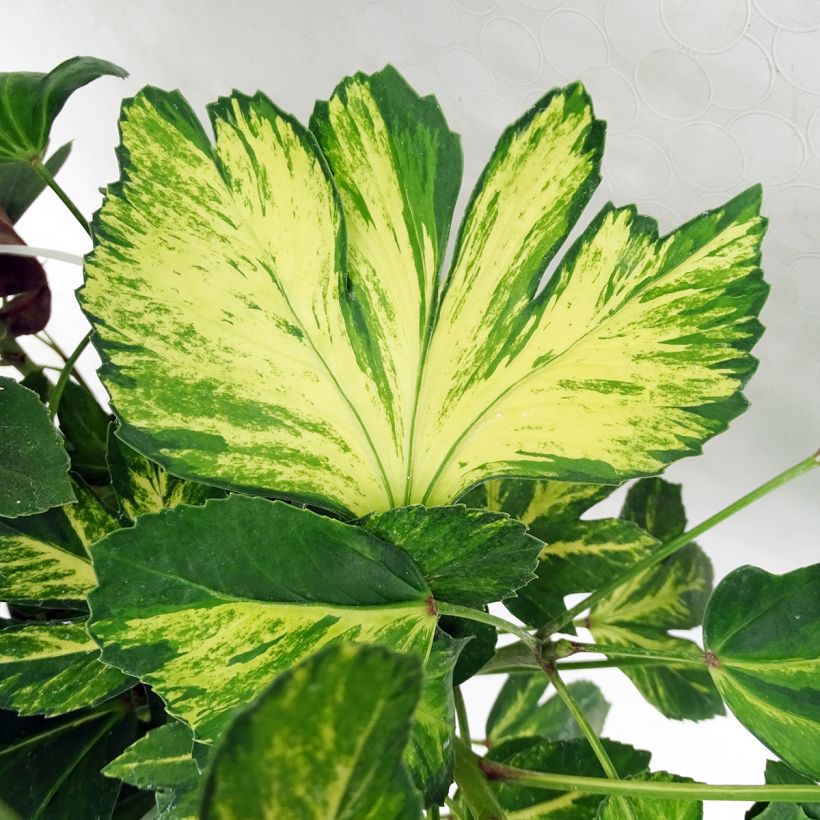

Plant habit
Flowering
Foliage
Botanical data
Pseudopanax
x lessonii
Gecko Gold
Araliaceae
Oceania
Other Pseudopanax
Planting and care
The Pseudopanax is grown in the ground in a mild climate, especially on the oceanic facade of our country, where well-drained, non or slightly chalky soils, and cool, humid summers are perfectly suited to its requirements. Elsewhere, it should be placed in a large pot filled with leaf compost, with drainage at the bottom, and watered with non or slightly chalky water. It prefers partial shade or morning sun exposure. Care should be taken to place it sheltered from strong or drying winds to protect its highly ornamental foliage.
Planting period
Intended location
Care
-
, onOrder confirmed
Reply from on Promesse de fleurs
Striking foliage shrubs
Haven't found what you were looking for?
Hardiness is the lowest winter temperature a plant can endure without suffering serious damage or even dying. However, hardiness is affected by location (a sheltered area, such as a patio), protection (winter cover) and soil type (hardiness is improved by well-drained soil).

Photo Sharing Terms & Conditions
In order to encourage gardeners to interact and share their experiences, Promesse de fleurs offers various media enabling content to be uploaded onto its Site - in particular via the ‘Photo sharing’ module.
The User agrees to refrain from:
- Posting any content that is illegal, prejudicial, insulting, racist, inciteful to hatred, revisionist, contrary to public decency, that infringes on privacy or on the privacy rights of third parties, in particular the publicity rights of persons and goods, intellectual property rights, or the right to privacy.
- Submitting content on behalf of a third party;
- Impersonate the identity of a third party and/or publish any personal information about a third party;
In general, the User undertakes to refrain from any unethical behaviour.
All Content (in particular text, comments, files, images, photos, videos, creative works, etc.), which may be subject to property or intellectual property rights, image or other private rights, shall remain the property of the User, subject to the limited rights granted by the terms of the licence granted by Promesse de fleurs as stated below. Users are at liberty to publish or not to publish such Content on the Site, notably via the ‘Photo Sharing’ facility, and accept that this Content shall be made public and freely accessible, notably on the Internet.
Users further acknowledge, undertake to have ,and guarantee that they hold all necessary rights and permissions to publish such material on the Site, in particular with regard to the legislation in force pertaining to any privacy, property, intellectual property, image, or contractual rights, or rights of any other nature. By publishing such Content on the Site, Users acknowledge accepting full liability as publishers of the Content within the meaning of the law, and grant Promesse de fleurs, free of charge, an inclusive, worldwide licence for the said Content for the entire duration of its publication, including all reproduction, representation, up/downloading, displaying, performing, transmission, and storage rights.
Users also grant permission for their name to be linked to the Content and accept that this link may not always be made available.
By engaging in posting material, Users consent to their Content becoming automatically accessible on the Internet, in particular on other sites and/or blogs and/or web pages of the Promesse de fleurs site, including in particular social pages and the Promesse de fleurs catalogue.
Users may secure the removal of entrusted content free of charge by issuing a simple request via our contact form.
The flowering period indicated on our website applies to countries and regions located in USDA zone 8 (France, the United Kingdom, Ireland, the Netherlands, etc.)
It will vary according to where you live:
- In zones 9 to 10 (Italy, Spain, Greece, etc.), flowering will occur about 2 to 4 weeks earlier.
- In zones 6 to 7 (Germany, Poland, Slovenia, and lower mountainous regions), flowering will be delayed by 2 to 3 weeks.
- In zone 5 (Central Europe, Scandinavia), blooming will be delayed by 3 to 5 weeks.
In temperate climates, pruning of spring-flowering shrubs (forsythia, spireas, etc.) should be done just after flowering.
Pruning of summer-flowering shrubs (Indian Lilac, Perovskia, etc.) can be done in winter or spring.
In cold regions as well as with frost-sensitive plants, avoid pruning too early when severe frosts may still occur.
The planting period indicated on our website applies to countries and regions located in USDA zone 8 (France, United Kingdom, Ireland, Netherlands).
It will vary according to where you live:
- In Mediterranean zones (Marseille, Madrid, Milan, etc.), autumn and winter are the best planting periods.
- In continental zones (Strasbourg, Munich, Vienna, etc.), delay planting by 2 to 3 weeks in spring and bring it forward by 2 to 4 weeks in autumn.
- In mountainous regions (the Alps, Pyrenees, Carpathians, etc.), it is best to plant in late spring (May-June) or late summer (August-September).
The harvesting period indicated on our website applies to countries and regions in USDA zone 8 (France, England, Ireland, the Netherlands).
In colder areas (Scandinavia, Poland, Austria...) fruit and vegetable harvests are likely to be delayed by 3-4 weeks.
In warmer areas (Italy, Spain, Greece, etc.), harvesting will probably take place earlier, depending on weather conditions.
The sowing periods indicated on our website apply to countries and regions within USDA Zone 8 (France, UK, Ireland, Netherlands).
In colder areas (Scandinavia, Poland, Austria...), delay any outdoor sowing by 3-4 weeks, or sow under glass.
In warmer climes (Italy, Spain, Greece, etc.), bring outdoor sowing forward by a few weeks.

































